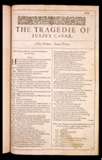Thomas Platter the Younger (1574-1628), the Swiss diarist, traveller, and physician, spent approximately a month in England in the autumn of 1599. In 1604-5, he recounted his travels in written form, including this anecdote of an afternoon out with his brother, Felix, to see what most scholars believe to be one of the first performances of Julius Caesar at the newly-erected Globe Theatre  by the Lord Chamberlain’s Men. (Their father, Thomas Platter the Elder (1499-1582) was a noted humanist who wrote an autobiography.) This precious journal entry has helped theater historians date the play (if it is indeed the one by Shakespeare) with some accuracy, and gauge the approximate number of actors that a playing company might use for a production:
by the Lord Chamberlain’s Men. (Their father, Thomas Platter the Elder (1499-1582) was a noted humanist who wrote an autobiography.) This precious journal entry has helped theater historians date the play (if it is indeed the one by Shakespeare) with some accuracy, and gauge the approximate number of actors that a playing company might use for a production:
Den 21 Septembris [1599] nach dem Imbissessen, etwan umb zwey uhren, bin ich mitt meiner geselschaft über dz wasser gefahren, haben in dem streüwinen Dachhaus die Tragedy vom ersten Keyser Julio Caesare mitt ohngefahr 15 personen sehen gar artlich argieren; zu endt dur Comedien dantzeten sie ihrem gebrauch nach gar überausz zierlich, ye zwen in mannes undt 2 in weiber kleideren angethan, wunderbahrlich mitt einanderen.
See Gustav Binz, “Londoner Theater und Schauspiele im Jahr 1599,” Anglia 22 (1899): 458; 456-64.
Here is the most frequently cited translation:
On the 21st of September, after dinner, at about two o’clock, I went with my party across the water; in the straw-thatched house we saw the tragedy of the first emperor Julius Caesar, very pleasingly performed, with approximately fifteen characters; at the end of the play they danced together admirably and exceedingly gracefully, according to their custom, two in each group dressed in men’s and two women’s apparel.
See Ernest Schanzer, “Thomas Platter’s Observations on the Elizabethan Stage,” Notes & Queries 201 n.s. (1956): 456-7.
Many recent editions of Julius Caesar refer the student to E. K. Chambers’s The Elizabethan Stage, 4 vols. (Oxford: Oxford University Press, 1923), 2:364-5, for the German text, without giving proper credit to the transcriber, Gustav Binz, or even naming his original article, which appeared in the scholarly German journal devoted to English literature, Anglia.
Gustav Binz (1865-1951) master librarian and philologist, was appointed Oberbibliothekar (library director) for the City Library of Mainz in 1909. He had previously been Professor für Anglistik, Bibliothekar und Philologe at the University of Basel, beginning in 1900. His specialty was Old and Middle English literature, but he was also extremely knowledgeable about incunabula and other materials associated with early printed books. He was naturally an excellent Director for the Stadtbibliothek, the Staatsarchivs, the Gutenbergmuseums and the Münzkabinetts for the City of Mainz. (The Gutenberg Museum and Society, both of which had been founded in 1900 to celebrate the 500th anniversary of the early printer’s birth, were located in the city’s library. Binz also edited the society’s publications.) His largest project, aided by the relatively new method for cataloguing, the Prussian Instructions, was to help overhaul the the Mainzer Sachkatalog for the century-old library’s some 200, 000 holdings, most of which were disastrously mislabled and misfiled. At the inception of the project, the staff consisted of only six people: a subject specialist, two librarians, a secretary, a volunteer, and Herr Doktor Binz. This enormous undertaking took some forty years to complete, and the library survived a depression and two world wars, not to mention the book-burning proclivities of the National Socialist Party. Binz returned to the University of Basel in 1920, where he continued to publish important studies of incunabula and Old English texts, both of which are still cited by scholars.
 Thomas Platter and Gustav Binz
Thomas Platter and Gustav Binz